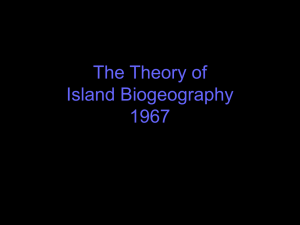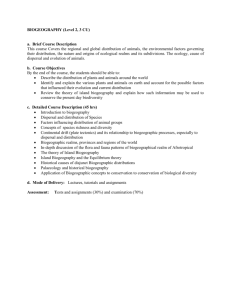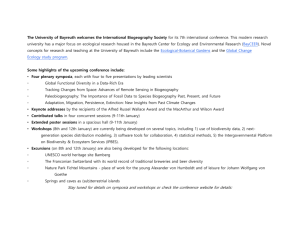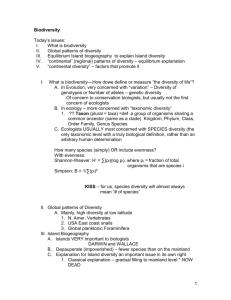Community Ecology
advertisement
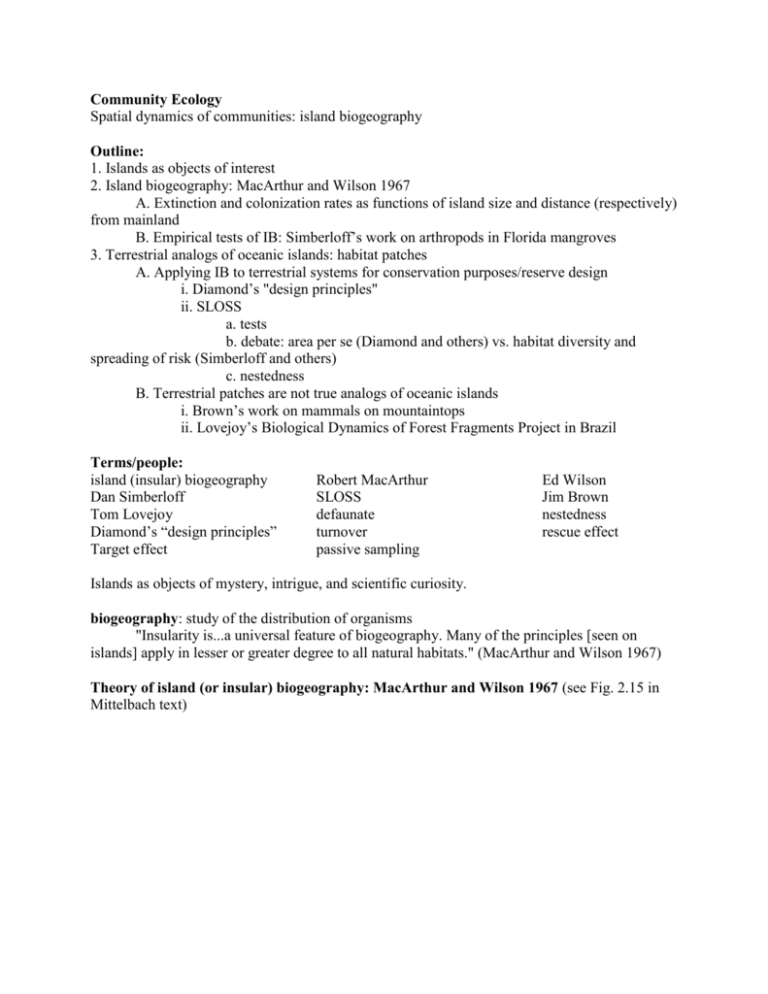
Community Ecology Spatial dynamics of communities: island biogeography Outline: 1. Islands as objects of interest 2. Island biogeography: MacArthur and Wilson 1967 A. Extinction and colonization rates as functions of island size and distance (respectively) from mainland B. Empirical tests of IB: Simberloff’s work on arthropods in Florida mangroves 3. Terrestrial analogs of oceanic islands: habitat patches A. Applying IB to terrestrial systems for conservation purposes/reserve design i. Diamond’s "design principles" ii. SLOSS a. tests b. debate: area per se (Diamond and others) vs. habitat diversity and spreading of risk (Simberloff and others) c. nestedness B. Terrestrial patches are not true analogs of oceanic islands i. Brown’s work on mammals on mountaintops ii. Lovejoy’s Biological Dynamics of Forest Fragments Project in Brazil Terms/people: island (insular) biogeography Dan Simberloff Tom Lovejoy Diamond’s “design principles” Target effect Robert MacArthur SLOSS defaunate turnover passive sampling Ed Wilson Jim Brown nestedness rescue effect Islands as objects of mystery, intrigue, and scientific curiosity. biogeography: study of the distribution of organisms "Insularity is...a universal feature of biogeography. Many of the principles [seen on islands] apply in lesser or greater degree to all natural habitats." (MacArthur and Wilson 1967) Theory of island (or insular) biogeography: MacArthur and Wilson 1967 (see Fig. 2.15 in Mittelbach text) Immigration is most strongly associated with island __________________. Extinction is most strongly associated with island ____________________. Rescue effect Target effect Passive sampling Tested empirically by Simberloff and Wilson 1969 (also Wilson and Simberloff 1969) in mangrove systems Applications to terrestrial analogs conservation ecology: Diamond 1975: derived "design principles" SLOSS debate Answer depends on nestedness? importance of area per se conserve for habitat diversity and for spreading of risk instead of area? Margules et al. (1982) warn against use of design principles without empirical data. The legacies of IB: 1. Focus on spatial properties such as area and isolation. 2. Interest in the fragility of island (or refuge) communities and the causes of this fragility. 3. Development of quantitative rules for refuge design. Thus, while IB provides a nice model, we need a more realistic way to study communities. Island biogeography, E.O Wilson and Dan Simberloff: http://www.pbs.org/wgbh/nova/nature/lord-ants.html (an hour-long show on the life of E.O. Wilson; go to 34:57 and watch to 41:20) Next time: Spatial dynamics of communities: landscape ecology References: Bierregaard, R.O., Jr., T.E. Lovejoy, V. Kapos, A.A. dos Santos, and R.W. Hutchings. 1992. The biological dynamics of tropical forest fragments. BioScience 42:859-866. Brown, J.H. 1971. Mammals on mountaintops: nonequilibrium insular biogeography. Am. Nat. 105:467-478. Coleman, B.D., M.A. Mares, M.R. Willig, and Y.H. Hsieh. 1982. Randomness, area, and species richness. Ecology 63:1121-1133. Diamond, J.M. 1975. The island dilemma: lessons of modern biogeographic studies for the design of nature reserves. Biol. Conserv. 7:129-146. Gilbert, F.S. 1980. The equilibrium theory of island biogeography: fact or fiction? J. Biogeogr. 7:209-235. Gotelli, N.J. 2001. A Primer of Ecology, 3rd ed. Sinauer Associates, Inc., Sunderland, MA. Janzen, D.H. 1983. No park is an island: increase in interference from outside as park size decreases. Oikos 41:402-410. Laurance, W.F., S.G. Laurance, V.F. Ferreira, J.M. Rankin-de Merona, C. Gaston, and T.E. Lovejoy. 1997. Biomass collapse in Amazonian forest fragments. Science 278:1117-1118. Losos, J.B., and R.E. Ricklefs, eds. 2010. The Theory of Island Biogeography Revisited. Princeton University Press, Princeton, NJ. MacArthur, R.H., and E.O. Wilson. 1967. The Theory of Island Biogeography. Princeton University Press, Princeton, NJ. Margules, C., A.J. Higgs, and R.W. Rafe. 1982. Modern biogeographical theory: are there any lessons for nature reserve design? Biological Conservation 24:115-128. May, R.M. 1975. Island biogeography and the design of wildlife preserves. Nature 254:177-178. Quammen, D. 1996. The Song of the Dodo: Island Biogeography in an Age of Extinctions. Touchstone, New York, NY. [a very readable book about island biogeography] Quinn, J.F., and S.P. Harrison. 1987. Effects of habitat fragmentation on species richness: evidence from biogeographic patterns. Oecologia 75:132-140. Simberloff, D.S. 1976. Experimental zoogeography of islands: effects of island size. Ecology 57:629-648. Simberloff, D.S. 1988. The contribution of population and community biology to conservation science. Annu. Rev. Ecol. Syst. 19:473-511. Simberloff, D.S., and L.G. Abele. 1976. Island biogeography theory and conservation practice. Science 191:285-286. Simberloff, D.S., and L.G. Abele. 1982. Refuge design and island biogeographic theory: effects of fragmentation. Am. Nat. 120:41-50. Simberloff, D.S., and E.O. Wilson. 1969. Experimental zoogeography of islands: the colonization of empty islands. Ecology 50:278-296. Stouffer, P.C., and R.O. Bierregaard, Jr. 1995. Use of Amazonian forest fragments by understory insectivorous birds. Ecology 76:2429-2445. Terborgh, J. 1976. Island biogeography and conservation: Strategy and limitations. Science 193:1029-1030. Thomas, J.W., E.D. Forsman, J.L. Lint, E.C. Meslow, B.R. Noon, and J. Verner. 1990. A conservation strategy for the northern spotted owl. Report of the Interagency Scientific Committee to Address the Conservation of the Northern Spotted Owl. Portland, OR. Whittaker, R.J., and J.M. Fernández-Palacios. 2007. Island Biogeography: Ecology, Evolution, and Conservation (2nd ed.). Oxford Univ. Press, Oxford.
